Riding a Bicycle IS Safe
Why the call for bicyclists to avoid highway is completely misguided.
Bicyclist and Bike Fed member Andrew Nowak was recently killed by a man driving a pickup truck on Highway 54 near Algoma. One of the comments we got in response to Tom Held‘s story about this asked why our organization doesn’t recommend people not ride on roads without wide paved shoulders. Here is the comment:
Mr Held,
I fail to understand why you would recommend riding to the left of the fog line when there is so much room to the right if it.
I notice that in most of your posts you do a great job of describing how motorists can drive more safely without any mention of good safe defensive riding for bicyclists. If your intention is to help make road riding for bicyclist more safe, why don’t you recommend a few things like:
- Use bike paths whenever possible
- Choose roads with asphalt right of the fog line and ride there
- Ride single file whenever cars are present
- Avoid riding when the sun is low in the sky
- Come to a complete stop at ALL stop signs
- Ride without earbugs so that traffic can more easily be heard
If the goal is to keep bicycles and cars from coming into contact with each other, both car drivers and bicycle riders share the responsibilities. It would be helpful if you would spend equal time in describing road safety to car drivers and bicycle riders. After all, it’s the bicyclist who has the most at risk and making recommendations like riding to the left of the fog line when there is room to the right of it sounds dangerous.
I think this comment and the suggestions were made in a respectful manner, but they reflect a pervasive culture among people who don’t ride bikes for transportation that blame the victim rather than the perpetrator in the United States. I try to answer questions like this in a way that helps people rethink the perspective that blames the victim and emphasizes the responsibility we all shoulder when we are driving a motor vehicle in a space we must share with other road users, some of whom are walking and bicycling. Below is my response:
Hi Jerry, relative to the fog line, according to state law and best safe practices, bicycles should ride as far to the right as is “practicable.” For most riders, that means leaving about three feet from hazards since bicycles stay upright in part by moving from left to right when the wind blows, including gusts from passing motor vehicles which tend to push a bicycle to the right. The one-to-two feet to the right of the fog line on this road is not sufficient width for safe travel.
Since people like this victim need to get to places like work that often do not have a separate path or even a wide-paved shoulder, it is necessary to ride to the left of the fog line. Since people in cars are doing the killing, using your logic but putting the responsibility where it belongs, you would be better to argue people should not drive on roads without wide paved shoulders when their visibility is limited if they think there may be people walking, bicycling or farmers using them.
Instead, we choose to ask that everyone who gets behind the wheel of a motor vehicle and operates that potentially dangerous moving object obey our laws and take their responsibility for other’s safety seriously and drive with extra caution when there’s a potential to cause serious injury or death through personal negligence.
As a further practical measure, we advocate that roads be constructed for the safe passage of all users. The purpose of our roads is to transport goods and people, not move people in cars. With proper design, a complete street is much safer for all users.
To reiterate what is mentioned in the post above, despite this tragic death, when the health benefits are factored in, riding a bicycle is probably safer than driving a car — and riding bicycles has a positive return to our society and communities, whereas driving personal motor vehicles, however necessary for many, has a negative return.
Thanks for reading and writing though, civil dialogue is always a good thing.
–Dave Schlabowske, Deputy Director, Wisconsin Bike Fed
Furthermore, while crashes like the one that killed Andy, whom I have ridden with recently on a couple Spring Classic rides, are horribly tragic, they remain relatively rare. Statistics show that riding a bicycle is actually very safe, and when you factor in the health benefits, riding a bicycle is more likely to lengthen your life than shorten it.
Recently there have been some studies done to quantify the relative risk of cycling and weigh that agains the health benefits.
For individuals who shift from car to bicycle, we estimated that beneficial effects of increased physical activity are substantially larger (3–14 months gained) than the potential mortality effect of increased inhaled air pollution doses (0.8–40 days lost) and the increase in traffic accidents (5–9 days lost). Societal benefits are even larger because of a modest reduction in air pollution and greenhouse gas emissions and traffic accidents.
Conclusions: On average, the estimated health benefits of cycling were substantially larger than the risks relative to car driving for individuals shifting their mode of transport.” Source: Do the Health Benefits of Cycling Outweigh the Risks? Jeroen Johan de Hartog1, Hanna Boogaard1, Hans Nijland2, Gerard Hoek1
Annual Risk Of Death During One’s Lifetime
| Disease and Accidental Causes of Deaths | Annual Deaths | Death Risk During One’s Lifetime |
|---|---|---|
| Heart disease | 652,486 | 1 in 5 |
| Cancer | 553,888 | 1 in 7 |
| Stroke | 150,074 | 1 in 24 |
| Hospital Infections | 99,000 | 1 in 38 |
| Flu | 59,664 | 1 in 63 |
| Car accidents | 44,757 | 1 in 84 |
| Suicide | 31,484 | 1 in 119 |
| Accidental poisoning | 19,456 | 1 in 193 |
| MRSA (resistant bacteria) | 19,000 | 1 in 197 |
| Falls | 17,229 | 1 in 218 |
| Drowning | 3,306 | 1 in 1,134 |
| Bike accident | 762 | 1 in 4,919 |
| Air/space accident | 742 | 1 in 5,051 |
| Excessive cold | 620 | 1 in 6,045 |
| Sun/heat exposure | 273 | 1 in 13,729 |
| Lightning | 47 | 1 in 79,746 |
| Train crash | 24 | 1 in 156,169 |
| Fireworks | 11 | 1 in 340,733 |
| Shark attack | 1 | 1 in 3,748,067 |
|
|
||
Sources: All accidental death information from National Safety Council. Disease death information from Centers for Disease Control and Prevention. Shark fatality data provided by the International Shark Attack File.
We also regularly share the following graphics about crash data from the Wisconsin Department of Transportation’s Bureau of Transportation Safety. We share it whenever people worry that riding a bicycle is dangerous, complain that traffic is just getting worse and worse, or admonish people for taking their life in their own hands by riding a bicycle in traffic. The fact is that bicycling is safe and has gotten increasingly safer.
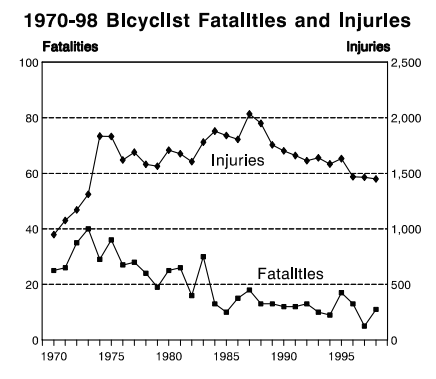
Fatal crashes involving bicycles have dropped from highs of 30 or more in the 1970s and hovered between zero and 15 in recent years.
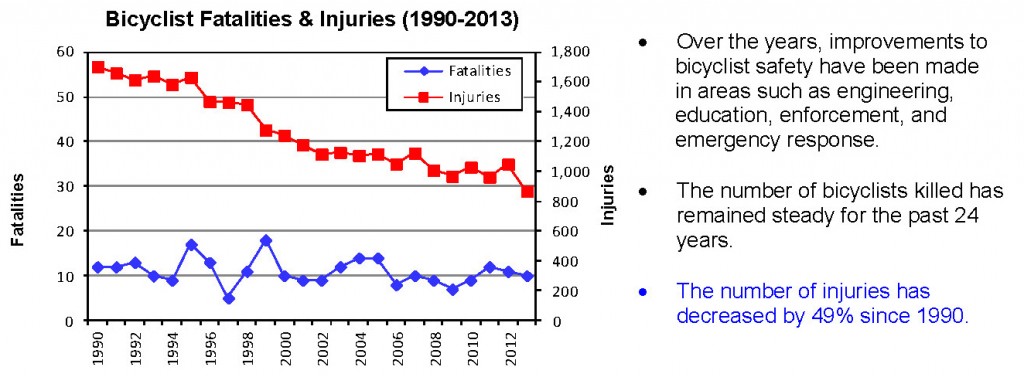
The number of crashes has been on the decline for years, even as the number of people commuting by bicycle increases. The fatal crash numbers are so small, that the variations from year to year are probably statistically insignificant. Given the number of people riding is going up, the actual fatal crash rate is declining too.
All the risk assessments like the one above that I have seen tend to show the risk of death for bicycling is lower than the risk of death in a motor vehicle. Some still argue we don’t have the best data for bicycling to fairly compare it to other activities that have been studied more. We are all for more studies and better data, but it seems clear already that in general, riding a bicycle is a pretty safe activity and much safer than driving a car.
Of course, like our partners at the Wisconsin DOT, we are working for safety improvements in engineering, education, encouragement and enforcement so that nobody dies in traffic-related deaths. Zero in Wisconsin is more than a vision, it is part of every roadway redesign and our improving traffic safety education programs like Share And Be Aware. We can all play an active role in moving closer to our goal by taking extra caution when we are driving a motor vehicle and following safe practices when walking and bicycling.
Bike Czar
-
Join a Bike Ride Under the Polish Moon
 Jun 1st, 2018 by Dave Schlabowske
Jun 1st, 2018 by Dave Schlabowske
-
9 Reasons to Join National Bike Challenge
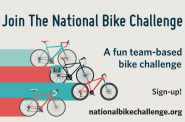 May 4th, 2018 by Dave Schlabowske
May 4th, 2018 by Dave Schlabowske
-
Biking Through the Mindoro Cut
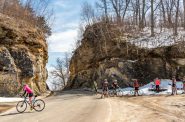 Apr 27th, 2018 by Dave Schlabowske
Apr 27th, 2018 by Dave Schlabowske
Transportation
-
MCTS Adds 28 New Buses
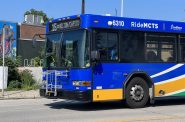 Jul 13th, 2024 by Graham Kilmer
Jul 13th, 2024 by Graham Kilmer
-
MCTS Designing New Bus Shelters
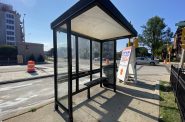 Jul 10th, 2024 by Graham Kilmer
Jul 10th, 2024 by Graham Kilmer
-
MCTS Updates RNC Bus Detours To Better Serve Downtown, Riders
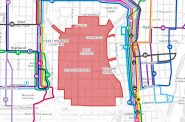 Jul 9th, 2024 by Jeramey Jannene
Jul 9th, 2024 by Jeramey Jannene





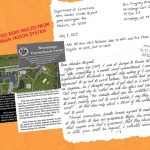
















I don’t think advocating for defensive riding is shifting the blame to the victims, especially in the way Jerry presented his comment. While the automobile is physical object causing death or injury, it’s not always the fault of the driver. Even if the driver is at fault, it makes sense to watch out for yourself first when riding. Just as a pedestrian has the right of way when walking in a cross walk… would you rather be “right” in the situation where the car should yield right of way but be dead because of the driver’s mistake… or would you rather watch out for bad drivers and stay alive by looking before crossing the street?
I highly support his bullet points and would also add reminding riders to NOT ride on sidewalks. I see near misses probably every other week downtown because someone is riding on the sidewalk and cars leaving parking lots or structures don’t expect them to zoom past.
Finally, I don’t think the left of fog line is a be-all-end-all rule. Sometimes, depending on the situation, I’ll right to the right of the line to protect myself. Although admittedly I tend to avoid highways like this anyway, which isn’t an option for everyone.
I ride thousands of miles a year on my bikes on road. Isn’t the death rate statistic misleading because that rate is for the general population. If you were to do a deaths per person per mile traveled, I’d guess bikes might come out closer or higher than cars on mortality rate. Any data to answer that question?
This doesn’t quite answer Ron H., but yes, one reason the figure is relatively low is that there are currently fewer people bicycling fewer miles than people are driving. However, keep in mind that
1) Right now the data show the direct risk of death by bicycling is 1 in 5000. Even if 10 times as many people start bicycling and nothing else changes, that figure would go to 1 in 500, and if 100 times as many people start bicycling, it would go to 1 in 50, which is on the same order of magnitude as the risk for driving.
2) Furthermore, other data not published here show that as the rate of bicycling increases in a place, bicycling becomes safer there because car drivers learn to share the road. So those 1 in 500 or 1 in 50 rates would decrease still further.
3) Most importantly, and the point of Dave’s article:
Bicycling reduces heart disease, high blood pressure, and obesity, which is where the greatest risks are, whereas car driving doesn’t.
Statistics mentioned are misleading. It would seem you need comparison of deaths/injuries per mile ridden or per hour ridden. Also, though likely not available, similar statistics for bicycle riders who regularly ride on actual roads, rather than the recreational rider that sticks to bicycle paths and like. I suspect riding in heavy traffic is actually pretty dangerous.
In regard to the “fog” line and sidewalk riding and stop signs, bicycles are not pedestrians and they are not vehicles. Sometimes it is necessary to ride on automobile side of fog line due, not only to width of shoulder, but not wanting to be trapped in small space between rapidly moving vehicles and road edge where the rider is subject to heavy road debris, potholes, sewer grates, car doors that may fly open, etc. Automobile drivers may not appreciate it, but sometimes offense is best defense. Moving into the lane necessitates the driver to actually pay attention to the bicycle, slow down, and take time to leave extra room when passing. Passing a bicycle at close range at maximum highway speed is not a good thing Moving into the lane near intersections also prevents the automobile from (barely) passing or not passing the bicycle then making sudden right turn in front or into the bicyclist which is common.
There is sometimes good reason (though probably not “legal”) for the bicyclist to enter sidewalk. Bicycle speed drops dramatically going up hills, decreasing stability, and increasing risk of being in the traffic lane. Sometimes there simply is not sufficient room to safely be on road between traffic and curb. Depending on sidewalk conditions including number of pedestrians, it may be much safer to abandon the road temporarily.
Finally, except at busy intersections, it almost never makes sense to come to complete stop on a bicycle, not to mention the inefficiency. It is difficult to get back to speed and a stopped bicycle has no defensive ability to maneuver away from errant vehicles or speedily cross intersections where necessary.
The laws around bicycle riding really address the problems in practical manner. Bicycles are not automobiles and bicycles are not pedestrians, though they have the ability to behave like either one depending on the conditions.
Sorry, I meant “The laws around bicycle riding do not really address”.
Or to rephrase what’s in item (1) above to better address Ron H.’s question,
Right now the data show the direct risk of death by bicycling is 1 in 5000.
To take into account that that is based on less mileage, we could estimate that if bicycle-miles-traveled (whether by increased trip length or by increased number of people) increased 10 times, then the risk would rise to 1 in 500. And if bicycle-miles-traveled increased by 100 times, then the risk would finally reach 1 in 50, finally surpassing the risk of death by car-driving. That’s not counting any benefits described in #2 and #3 above (better road-sharing, better health).
JTB, I think you are getting to my point, which is despite the tragic fatal crashes, people should not worry a lot about their safety when riding a bicycle and following the rules of the road. So be careful at conflict points (intersections, driveways, etc.), ride according to best practices, and remember the health benefits are overwhelmingly to your advantage. That said, I have to admit that it would be helpful to have better statistics on riding bicycles in terms of exposure hours and vehicle miles traveled.
Ron, there really isn’t much good data on bicycle miles traveled or exposure hours, which might be an even better way of looking at crashes from one travel mode to another. You are probably right that if we were to have that data, it would skew the risk upwards.
AG: Regarding not riding on sidewalks, I agree but still choose the sidewalks when riding with children. Few streets in Milwaukee feel safe for kids on bikes, even when there are bike lanes. When on the sidewalk I teach mine to stop at driveways, go at a slow speed, yield to walkers, and of course stop at cross-walks. Cars passing in the bike lanes, opening doors, and not yielding much room when overcoming bikers makes me choose the sidewalk when traveling with young riders.
I wish we would address visibility as a safety action. Workers rear reflective clothing and I think we should, too. Put on your helmet and put on a vest, then get on your bike. When a vehicle hits a bike, no matter who is at fault, the person will be hurt and lives will be effected. We need to be proactive for our own safety.
Exactly the reason we need bicycle boulevards and protected bike lanes in Milwaukee and in other urban areas in Wisconsin. Most people who ride bicycles want to ride more but don’t because they do not feel safe riding in regular bike lanes. Even if statistics show it is very safe, if people don’t feel safe, they won’t ride there. I can tell my wife how safe a roller coaster is, but I won’t get her to ride on one because she doesn’t enjoy feeling scared. Cities like Chicago, New York, Washington, D.C., Portland, Minneapolis, etc., have dramatically increased the number of people bicycling with protected lanes on arterial and collector streets and traffic-calmed neighborhood side streets. I would be remiss here though if I did not mention that it is illegal to ride on the sidewalk if you are 10 or older in Milwaukee and it is often more dangerous to ride on the sidewalk unless you ride as you describe Nathan. That said, I have not heard of an adult with children being ticketed for riding on a sidewalk. I have heard of adults being ticketed or warned riding on sidewalks in business distircts, but not along neighborhood side streets.
No mention of owning a gun or living with someone who owns a gun? That is a serious risk Even though it has nothing to do with bicycles.
As an avid rider and bike commuter for the last 8 years, I’d say asking people driving automobiles to take more accountability and riders to use more defensive tactics are both correct answers. I can’t tell you how many times I have seen reckless riders cut through a stop sign going around a dangerous/blind corner, or how stupid I always think it is when I see people trying to ‘group ride’ to the point that they are sticking out into a lane. Your own safety should always be your top priority when riding a bicycle, and the more you can do to stick to that bottom line, the better. It would be nice if automobile drivers would be more weary when driving, but you can’t rely on that as a rider and absolutely should practice safe riding practices as much as possible.
Look it, every dies. The fact that more people die of heart disease than bike riding is really beside the point. Your comparison of Annual Risk Of Death During One’s Lifetime does not tell us that bike riding is relatively safe. It tells us that relatively few people ride bikes in comparison to everyone who has a heart that can fail.
Also, dying from cancer at 84 years old is very different than being killed on a bike at 34.
State in terrible shape on roads right, now and for the next ten years. Doubtful they will spend lots of money on bike lanes. Too bad, I ride the bike paths almost every day, year round. Bikes need to pay road taxes.
Our family ran bike races, I was bike racer, coach, as were my five kids.
Riding on busy hi ways, no-good idea. I have lost 4 good friends from doing that. Stick to areas where traffic is ok, avoid the crunch places where you have to around cars that might open doors.
Above all ,where bright clothing and avoid running at night if at all possible. Strobe lights great idea.